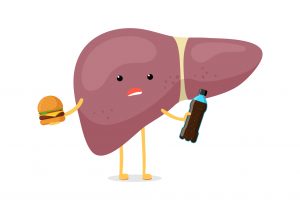
Of course, you can see that so you know it’s there. Further, the fat on your chin or your arms isn’t really harmful to your health. The fat around your midsection can be an indicator of overall health, but at least you can see it. But what about fat in your liver?
You can’t see liver fat. You can even be in great physical condition and sitting at a normal healthy weight and still have fatty deposits in your liver. Left unchecked, a fatty liver can be extremely dangerous.
Liver fat can cause inflammation and scarring, which can potentially lead to fatty liver disease and impaired liver function. This means this important organ is no longer able to process and remove toxins or absorb nutrients optimally.
Quite frankly, it can put your life in danger.
But are there any indicators that you could be storing liver fat?
It depends.
Some of you will need to see a doctor because liver fat can be genetic. It doesn’t mean it is dangerous; it could just be that’s a place on the body that stores fat. You could be at a healthy weight and fat percentage and still have some liver fat.
If your doctor is keeping an eye on it and you’re living a healthy lifestyle, it may not progress into anything dangerous.
Obesity can be an indicator that you are carrying fat in your liver. Fat accumulation does not discriminate and will settle anywhere on the body. If you’re carrying a lot of fat around the midsection, you could be at higher risk for elevated levels of liver fat.
The foods that lead to weight gain – processed foods, refined grains, sugary snacks, and beverages – can also be a major driver of fatty liver disease. They are attributed to a growing health problem called non-alcoholic fatty liver disease, or NAFLD, that is becoming increasingly common across age cohorts. Cases seem to go hand in hand with obesity.
Liver disease symptoms may arise when the condition has progressed unchecked for an extended period, if they appear at all. Some include:
- Fatigue
- Confusion
- Weakness
- Jaundice
- Yellow eyes
- Dark urine
- Abdominal pain
If you’re experiencing any of these symptoms, contact your doctor immediately. In the meantime, you can try to prevent accumulating liver fat by maintaining an active lifestyle, eating plenty of fruits and vegetables, and limiting the intake of alcohol and processed food.